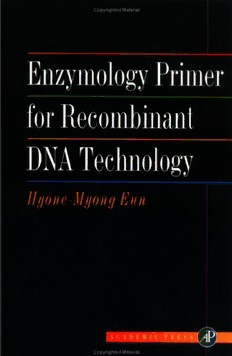
Enzymology primer for recombinant DNA technology PDF
Preview Enzymology primer for recombinant DNA technology
Preface A vast array of molecular biological techniques currently used in gene analyses and nucleic acid manipulations depend on the catalytic power of enzymes. With the discovery of site-specific restriction endonucleases and their use in combination with other enzymes that synthesize, cut, link, degrade, and modify DNA and RNA, the burgeoning era of recombinant DNA technology has begun. Thanks to recombinant DNA technology, the structure and function of a gene or a protein can now be dissected and characterized at a molecular level with greater ease, and valuable proteins can be produced in a safe, convenient, controlled, and economic manner. In the past decade, we have witnessed explosive advances in and diversification of recombinant DNA technology with far-reaching implica tions. These advances have been drastically changing the pace of progress in bioscience and reshaping bioindustries. Their applications are limited only by our imaginations. They have given rise to new disciplines such as "genetic engineer ing," "protein engineering," and "biotechnology." At the foundation of these new technologies is recombinant DNA technology, which in turn is based on the specificity and efficiency of the catalytic enzyme molecules. Past progress of these technologies is due to a large extent to enzymes, and further advances will un doubtedly require greater roles for enzymes. By classical definition, an enzyme is a protein, but this definition should now be expanded to include nucleic acid enzymes as well. As a biological macromolecule endowed with catalytic function(s), each enzyme has its reaction specificity, sub strate specificity, and optimal reaction conditions. It can be inhibited, degraded, xi xii Preface or denatured by physical interactions with nonenzymic molecules during reaction and storage conditions. Enzymes are sophisticated, ingenious molecular machines, "operating at the boundary where chemistry just becomes biology" [Kraut, J. (1988). Science 242, 533]. Only judicious use of enzymes leads to the best results in recombinant DNA research. Yet enzymes are more often regarded as simple reagents, the use of which is frequently guided by insufficient description in technical manuals and catalogs. Enzymology has made tremendous progress in recent years, and our knowledge of enzyme catalysis is rapidly increasing. This is due in large part to the application of recombinant DNA technology to the study of enzymes themselves. For most nonenzymologists involved in recombinant DNA research, however, it is difficult, if not impossible, to keep pace with the rapid advances in enzymology. The primary goal of this book is, therefore, to help molecular biologists and recombinant DNA technologists to better understand the inner workings of these biocatalysts as they are utilized in recombinant DNA techniques. Thus it provides information for more judicious, appropriate, and creative use of enzymes as tools. The book is organized as a quick reference source to the biochemical, biophysi cal, and catalytic properties of selected enzymes. It is designed to be a companion to technical manuals which focus on step-by-step procedures for certain molecular biological techniques. Since every book must be selective in its content, I have chosen to include only those enzymes that are most commonly used in present- day recombinant DNA technology. A conscious effort has been made to present only information relevant to and practical for recombinant DNA technology, largely omitting historical and theoretical aspects of enzymology. The topics appear in eight chapters. Chapter 1 describes the functional and structural principles of enzymes and nucleic acids in general. It provides the reader with the basic concepts of enzymology, nucleic acid chemistry, and molecular biology on which recombinant DNA technology is based. It presents terminology relevant to new concepts or techniques. Chapters 2 through 8 describe the bio chemical and biophysical properties and molecular genetics of selected enzymes, which are arranged in alphabetical order. Chapter 8 is followed by Appendixes A-C: (A) a glossary of methods treating fundamental concepts of some landmark molecular biological techniques; (B) genotypes of £. coli strains commonly used in recombinant DNA technology; and (C) a general guide for enzyme handling. Each chapter is subdivided into sections beginning with a short introduction or general description, which gives a brief overview of the subject. Then functional, structural, and genetic aspects of each enzyme are described, with examples of typical applications. Functional aspects include (1) reaction conditions (optimal or recommended reaction conditions, kinetic parameters, cofactor requirements, and inhibitors/inactivators); (2) activity assay and unit definition; (3) substrate specificity; and (4) catalytic mechanism. The section on enzyme functions should enable the reader to predict the possible outcome of a reaction under a given condition and provide the basis for which the activity of an enzyme can be optimized or fine tuned to obtain the desired results. The applications section presents some typical examples illustrating the basic
